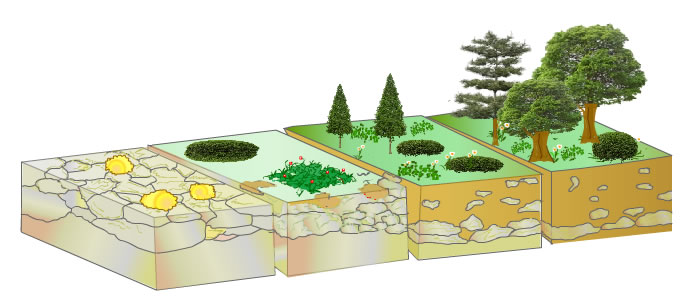We explain Ecological Succession Example In Biology and its relationship with evolution and primary and secondary succession. Ecological succession is a dynamic process that occurs in all ecosystems and modifies them, developing stability over time.
Ecological Succession Example In Biology.

These are some clear examples of ecological succession .
Lake Michigan Dunes
After the end of the last ice age, the glaciers that covered the Great Lakes gradually retreated, exposing large dunes. These dunes are large sand formations that accumulate on the shores of lakes.
Over the years there have been a succession of plant species. Firstly, drought-tolerant species were established, which also allowed the fixation of the dunes, preventing the wind from eroding and transporting them. After about twenty years, grasses appeared, shrubs such as sand cherry and trees such as willows and poplars, which continued to stabilize the substrate.
After another 50 or 100 years, the pine forests began to grow rapidly, which were finally replaced by oak groves, and could be maintained for millennia. Currently, this sequence of plants can be observed, since the lakes have a lower level and the process continues over time.
Clogging of a lake
An oligotrophic (low nutrient) lake begins to receive nutrients and sediment from the streams and rivers that flow into it. Thanks to the increase in nutrients, algae begin to proliferate. If the nutrients increase, floating aquatic plants appear and others that begin to take root. The death and decomposition of the organisms cause remains to accumulate at the bottom of the lake and peat is created, while it loses depth. In this way the lake begins to transform into a swamp.
The soil becomes acidic and plants typical of the banks such as reeds begin to proliferate. Terrestrial animals such as earthworms and some insects may appear. Trees that tolerate high humidity well, such as alders or birches, grow on the formed peat bogs. Over time they will be replaced by other trees that will form a more mature forest.
The fauna of the place also evolves, amphibians disappearing due to the lack of humidity and birds and mammals typical of the forests appear. In the event that there is a lot of peat, a lot of moss would grow which would acidify the soils so much that the trees would die.
This process has originated the current peat bogs on the planet after the glaciations and could happen within thousands of years in lakes such as Geneva or Geneva, the largest lake in Western Europe and located in the Alps, and in Lake Constance, which borders with Germany, Switzerland and Austria.
Among the most common examples of secondary succession are abandoned agricultural lands, burned or cleared forests, land that has been flooded to create artificial ponds or lagoons, among others.
In some regions where agricultural land is abandoned, such as Oklahoma or central North Carolina in the United States, secondary successional sequences can be observed, where weeds are usually the pioneer colonizers, followed by annual grasses, tall grasses and tree species
